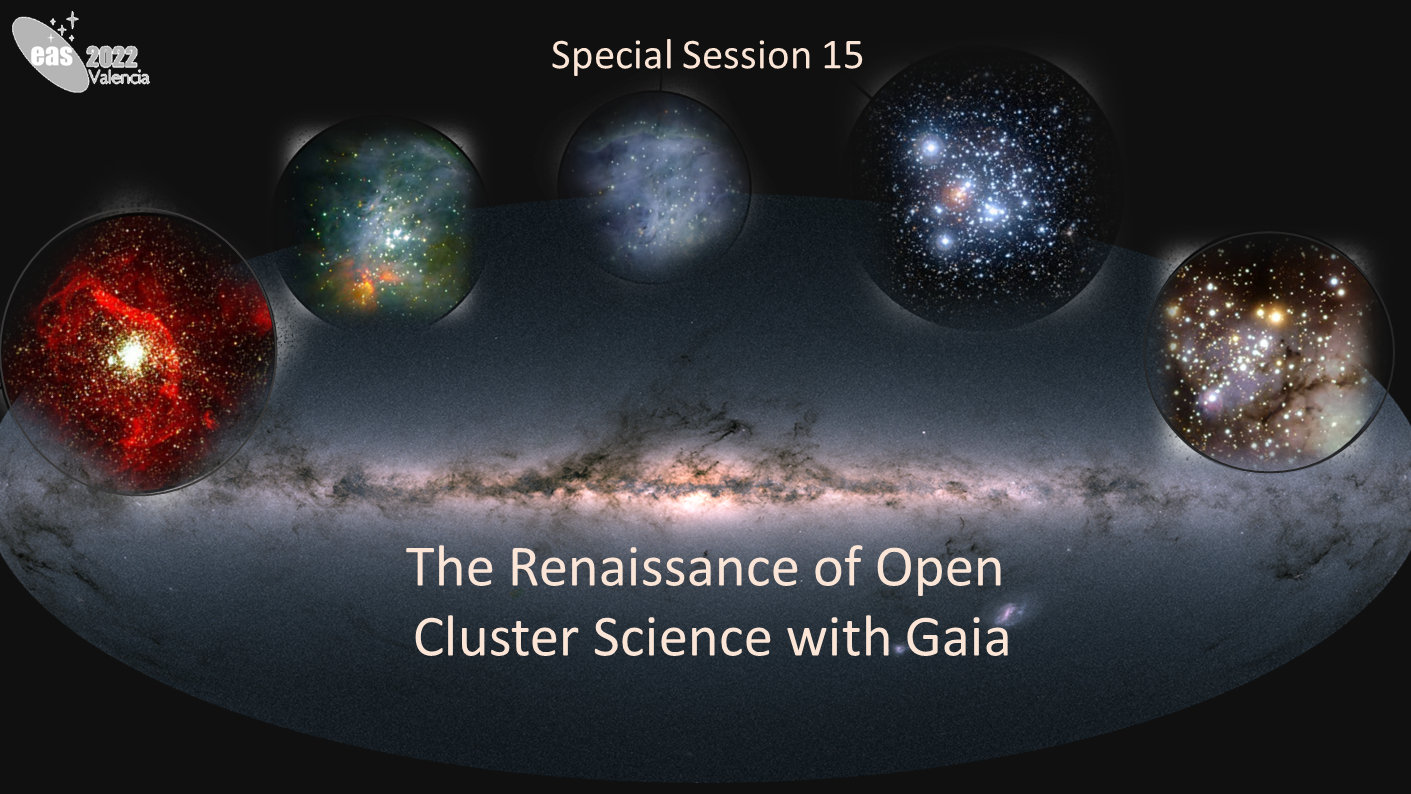Special Session (incl. Lunch) SS15
29 June 2022
The Renaissance of Open Cluster Science with Gaia

Aims and scope
Star clusters are key constituents in the study of many fields of astrophysics, from star formation, to stellar and galactic evolution and, finally, to cosmology. In this general framework, Galactic open clusters are a key reference point, playing a predominant role in various aspects of Galactic Archeology, such as the investigation of aspects of stellar evolution, of the mixing processes within the stellar photospheres (extra mixing and diffusion), of the origin of the field population, through the so-called chemical tagging. In addition, open clusters are used to calibrate empirical relationships between the properties of stars and ages, and then to infer field star ages). They are among the best test particles to probe the conditions of galaxies now and back in time and to trace the structure of our Galaxy.
The ESA Gaia mission and the concomitant large spectroscopic surveys have led to a true renaissance of interest in this field. A few examples are: the discovery of hundreds of new clusters; the characterisation of extended stellar structures identified either as relics of filamentary star formation or tidal tails; and the detailed study of their properties, such as age, chemical composition and orbits. The study of the stellar population of close-by star forming regions reveals in many cases the presence of several kinematically distinct sub-populations and the presence of distinct bursts of star formation.
In this panorama, this SS+LL will be very useful i) to highlight the recent results obtained thanks to the Gaia EDR3 database, which has provided improved positions, parallax, proper motion for thousands of clusters; ii) to discuss results based on the recent releases of Gaia-ESO (final data release) and APOGEE (DR17), two large spectroscopic surveys that have dedicated a remarkable fraction of their observing time to clusters; iii) to announce new projects and surveys relevant for the field, some just started (WEAVE@WHT), others about to start (MOONS@VLT, 4MOST@VISTA), along with new instruments planned for the coming years, such as MAVIS and HRMOS, which will focus also on star clusters.
Programme
- Session 1
Open clusters and the Milky Way: a post-Gaia view
We will discuss the discovery of new clusters (or the exclusion of candidates) based on the latest Gaia catalogue or other sources and their interest in defining the completeness of the Galactic open cluster populations. The use of open clusters in defining the spiral arms and their evolution shall be explored. We also expect to hear more on filamentary structures, tails, haloes, on the expansion of the clusters and on cluster formation (also present in the LS).
- Session 2
Open clusters: the importance of spectroscopic surveys
We will discuss the importance of precise and accurate radial velocities and detailed chemical abundances for internal kinematics, dynamical evolution, orbits, chemical evolution of the MW. We expect new results based on large surveys such as Gaia-ESO, APOGEE, GALAH, LAMOST, or on smaller surveys, whose strength lies on precision more than on large numbers.We will discuss the expectations for WEAVE, MOONS, 4MOST and for later instruments.
- Session 3
Open clusters: the best calibration tools
Stellar clusters, in particular the single-population open clusters, are the best tools for test of stellar models and calibrations. We expect to hear the latest news i) in the field of stellar evolutionary models and atmospheres (e.g. 3D, NLTE); ii) in the determination of the evolution of surface chemical abundances due to diffusion, mixing, etc; iii) in calibration of empirical chemical clocks to be applied to field stars; iv) in combination with asteroseismology; and v) in internal and cross-survey calibration.
- Lunch Session
Cluster formation and early evolution
We will focus on models (with an eye also on the observations required to inform and test them), on what we know and do not know on clustered star formation and on how clusters form, evolve and eventually dissolve.
Invited speakers
- Tristan Cantat-Gaudin (Max Planck Inst. for Astronomy, Heidelberg, Germany)
- Sofia Randich (INAF-Osservatorio Astrofisico di Arcetri, Italy)
- Nadege Lagarde (Laboratoire d'Astrophysique de Bordeaux, France)
- Mark Gieles (Universitat de Barcelona, Spain)
Scientific organisers
Angela Bragaglia (chair), INAF-OAS Bologna, Italy
Lola Balaguer-Nuñez, IEEC-Uni. Barcelona, Spain
Giacomo Beccari - European Southern Observatory
Alfred Castro-Ginard, Leiden University, The Netherlands
Gayandhi De Silva, Macquarie University, Australia
Laura Magrini, INAF-OA Arcetri, Italy
Stefan Meingast, Vienna University, Austria
Rodolfo Smiljanic (co-chair), Nicolaus Copernicus Astronomical Center, Poland
Antonella Vallenari, INAF-OA Padova, Italy
Contact
angela.bragaglia @ inaf.it
Updated on Tue May 24 09:38:38 CEST 2022
|